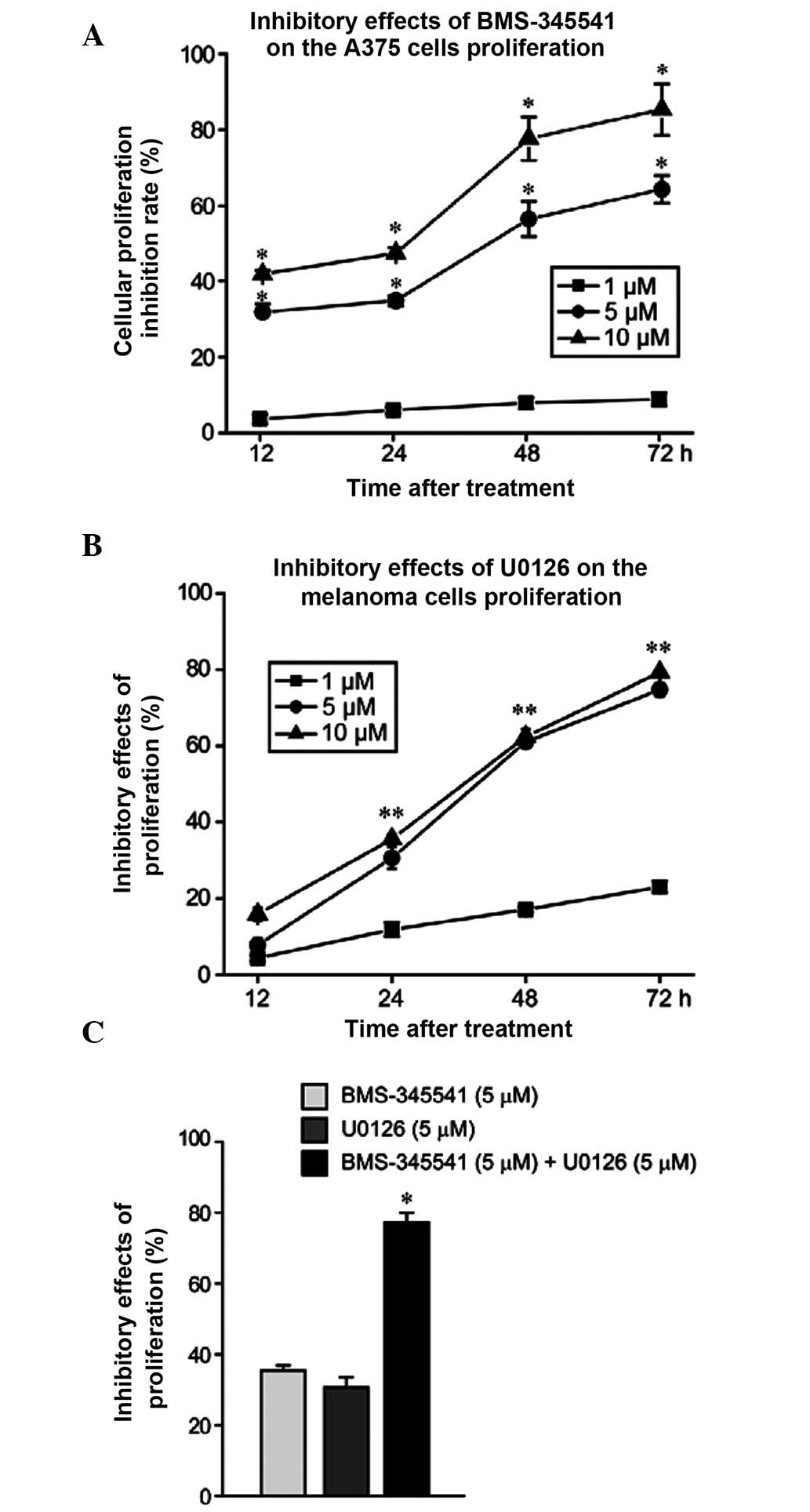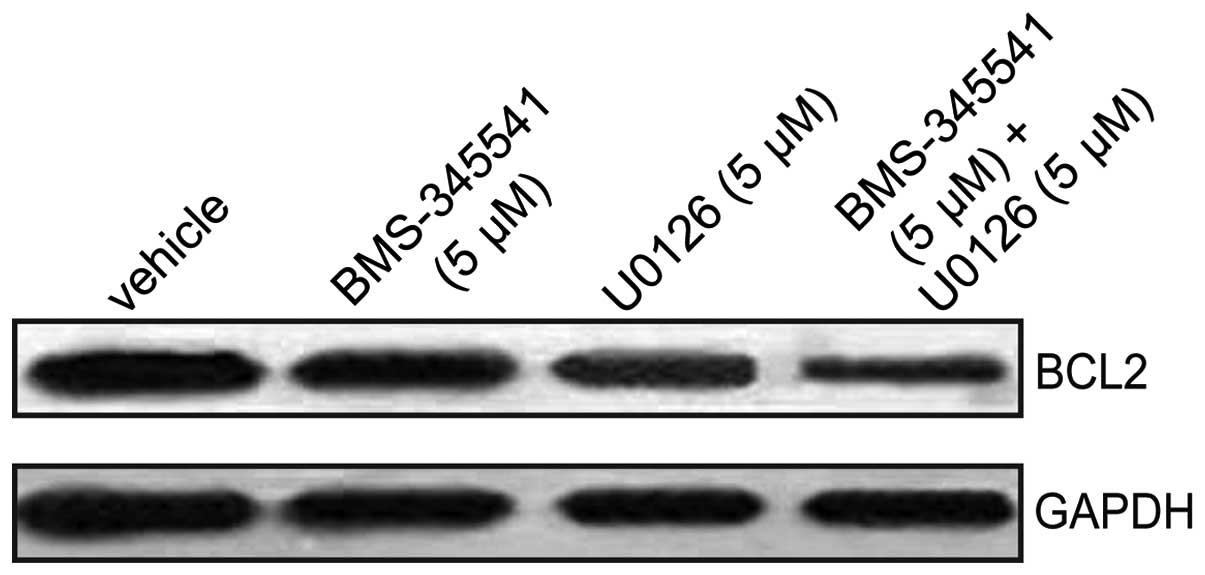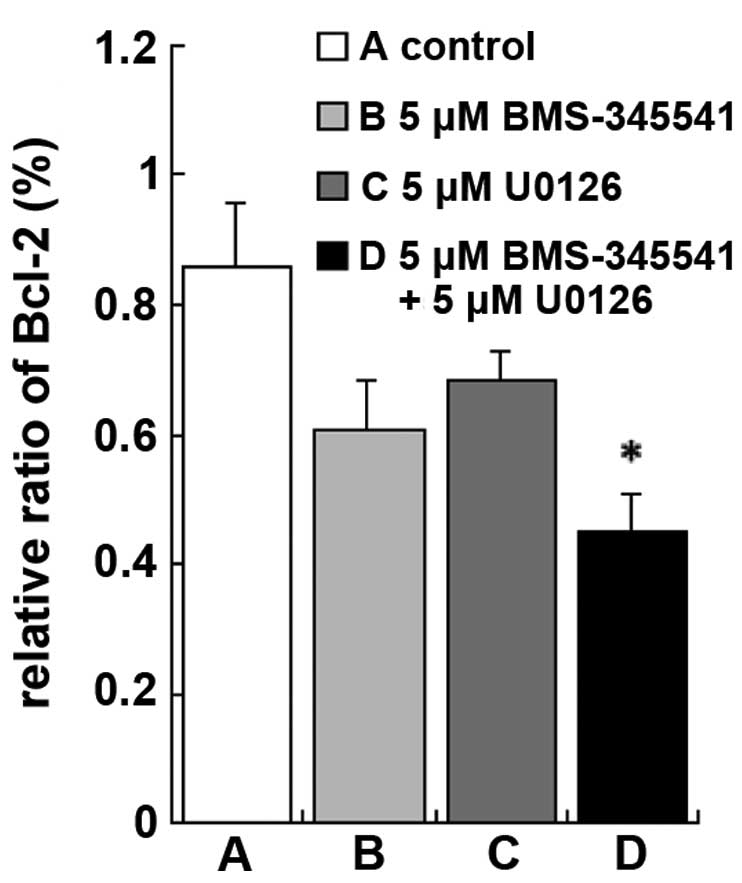Effects of nuclear factor-κB and ERK signaling transduction pathway inhibitors on human melanoma cell proliferation in vitro
- Authors:
- Published online on: September 3, 2015 https://doi.org/10.3892/ol.2015.3672
- Pages: 3233-3237
Abstract
Introduction
Malignant melanoma is the most aggressive type of skin cancer, and its incidence and mortality have increased steadily over the last 50 years to 3% of all tumors (1). Prognosis is poor once melanoma has metastasized, with a median survival time of 4–6 months (1,2). The B-Raf inhibitor dabrafenib, in combination with MEK inhibitor trametinib were approved in 2013 by the Food and Drug Administration as a treatment strategy for unresectable or metastatic BRAF-mutated melanoma. Compared with BRAF-inhibitor monotherapy, combined therapy offers an improved response rate for the treatment of advanced melanoma. However, similar to monotherapy, associated toxicity and tumor resistance and progression are still observed in the majority of patients (3).
Previous studies have revealed that activating BRAF kinase mutations drive oncogenesis in a wide variety of malignancies, most notably so in melanoma (~70% of cases). These mutations reduce the activation state of the Raf-MEK-ERK mitogen-activated protein kinase signalling pathway, which is involved in the growth of Raf-mutated melanoma (4), and B-Raf has been exploited as a novel therapeutic target for melanoma in recent years. The present authors have previously demonstrated that the MEK/ERK inhibitor U0126 is capable of inhibiting the proliferation of the A375 human malignant melanoma cell line in vitro. However, the cells develop resistance to U0126, preventing a durable response (5), a phenomenon shared with other MEK/ERK inhibitors (6). Various studies have demonstrated that inhibiting the nuclear factor (NF)-κB signaling pathway increases the cytotoxicity of anticancer agents, thus, reducing multiple drug resistance in the tumor (7,8). However, there are no reports on the synergistic effect of MEK/ERK and NF-κB inhibitors on melanoma cell proliferation in the current literature.
The aim of the current study is to evaluate the effects of the NF-κB inhibitor BMS-35541 and the MEK/ERK inhibitor U0126, alone or in combination, on the proliferation and apoptosis of human melanoma cells in vitro. This may increase the field of applications for MEK-targeted therapy.
Materials and methods
Cell culture
The A375 human malignant melanoma cell line was purchased from the Cell Bank of the Chinese Academy of Sciences (Shanghai, China). The cells were cultured in Dulbecco's modified Eagle's medium (GE Healthcare Life Sciences, Logan, UT, USA) and supplemented with 10% fetal bovine serum (FBS; GE Healthcare Life Sciences, Little Chalfont, UK), 100 U penicillin and 100 µg streptomycin at 37°C in a humid atmosphere of 5% CO2. The study protocol was approved by Ethics Committee of the Affiliated Hospital of Qingdao University (Qingdao, China).
Proliferation inhibition assay
A375 cells were seeded into 96-well plates at a density of 1,000 cells/well. Following incubation in 10% FBS medium for 24 h, the cells were then incubated with either 150 µl/well dimethyl sulphoxide (DMSO; vehicle control), the ERK inhibitor U0126 (1,5 or 10 µmol/l), the NF-κB inhibitor BMS-345541 (1,5 or 10 µmol/l), or U0126 and BMS-345541 in combination (5 µmol/l). At timepoints of 12, 24, 48 and 72 h following treatment, cell viability was assessed using the 3-(4,5-dimethylthiazol-2-yl)-2,5-diphenyl-tetrazolium bromide (MTT) assay (9). Optical density values were determined and the rate of inhibition of cellular proliferation was calculated using the following equation: (1 - mean ODexperimental group) / (mean ODcontrol group) × 100% (9). The combined effect of U0126 and BMS-345541 was determined as previously described (10). DMSO, U0126, BMS-345541 and MTT were all purchased from Sigma-Aldrich (St. Louis, MO, USA). The proliferation inhibition assay was performed three times.
Flow cytometry
A375 cells were seeded into six-well plates and treated with inhibitors, as described in the proliferation assay. At 12, 24, 48 and 72 h after treatment, cells were harvested and stained with fluorescein isothiocyanate-labeled annexin V and propidium iodide (PI; Sigma-Aldrich). Cell cycle progression and apoptosis was analyzed using a FACSCalibur™ flow cytometer and CellQuest™ software (BD Biosciences, San Jose, CA, USA).
Western blotting
A375 cells were plated onto dishes and treated with various inhibitors, as described in the proliferation assay. At the end of the designated culture period, cells were washed twice in ice-cold phosphate-buffered saline (PBS) and then lyzed in ice-cold radioimmunoprecipitation assay lysis buffer. Cell homogenates were obtained following the removal of non-soluble debris by centrifugation at a high speed for 20 min at 4°C. Homogenized proteins (20 µg) were loaded into a 12% polyacrylamide gel, separated by SDS-PAGE and transferred onto a nitrocellulose membrane using a Transblot® apparatus at 100 V for 90 min. The membrane was sequentially incubated with polyclonal mouse anti-human Beclin-2 (cat no. ZM-0010; 1:400 dilution) and monoclonal mouse anti-human GAPDH (cat no. ab8245; 1:1,000 dilution) primary antibodies, followed by horseradish peroxidase-conjugated goat anti-mouse IgG (cat no. ZDR-5307; 1:10,000 dilution) secondary antibody. All antibodies used were diluted in Tris-buffered saline with Tween 20 and purchased from OriGene Technologies, Inc. (Beijing, China). The membranes were washed with PBS three times for 10 min during and after immunolabelling. Protein expression was quantified using ImageJ software (National Institutes of Health, Bethesda, MD, USA).
Statistical analysis
Data were analyzed by one-way analysis of variance and Student's t-test, using SPSS version 10.0 statistical software (SPSS Inc., Chicago, IL, USA). P<0.05 was considered to represent a statistically significant difference.
Results
Cell viability
At all timepoints, BMS-345541 demonstrated a significantly higher ability to suppress A375 cell proliferation when used at 5 and 10 µmol/l compared with 1 µmol/l (P<0.05, Fig. 1A). By contrast, the inhibitory effect of U0126 was not significantly different between 5 and 10 µmol/l and 1 µmol/l at 12 h (P>0.05), but became significantly different at 24, 48 and 72 h (P<0.05; Fig. 1B). The half maximal inhibitory concentration at 24 h was ~5 µmol/l for both drugs. When BMS-345541 and U0126 were used in combination, the inhibition rate of cell proliferation was significantly higher than when they were used alone (P<0.05; Fig. 1C).
Cell cycle progression
Compared with the untreated controls (Fig. 2A), treatment with BMS-345541 for 24 h (Fig. 2B) significantly increased the proportion of A375 cells in G1 (62.97% vs. 69.13; P<0.01) and G2 (15.6 vs. 7.57%; P<0.01), but there was a significant reduction in the proportion of cells in S phase (29.47% vs. 15.27; P<0.01). U0126 significantly increased the percentage of cells in G1 phase (84.80 vs. 62.97%; P<0.01) and decreased the percentage of cells in S phase (11.07 vs. 29.47%; P<0.01) and G2 phase (4.13 vs. 7.57%; P>0.01). In the combination group, the proportion of cells in G1 phase fell between those of the BMS-345541 group and the U0126 group (73.43%; P<0.01); the percentage of G2 phase cells was marginally higher than in the BMS-345541 group (16.3 vs. 15.6%); and the percentage of S phase cells reduced to 6.83% (P<0.01).
Cell apoptosis
Apoptosis was induced more frequently in the A375 cells treated by BMS-345541 in combination with U0126 than when used with either inhibitor alone. The apoptosis rate in the BMS-345541 (5 µmol/l) and U0126 (5 µmol/l) increased by 24.98% (t=9.74, P<0.01) and 13.96% (t=15.82, P<0.01), respectively, compared with the control group. Furthermore, the apoptosis rate of the combination group (5 µmol/l BMS-345541 plus 5 µmol/l U0126) increased by 38.91%, which was significantly more than that of the control group (t=8.15, P<0.01; Fig. 3).
Changes in Bcl-2 protein expression levels
To further explore the mechanism by which BMS-345541 and U0126 induce A375 cell apoptosis, western blotting was used to measure the protein expression levels of Bcl-2, a known regulator of apoptosis. Treatment with BMS-345541, in combination with U0126 resulted in a significant reduction in Bcl-2 protein expression compared with the control, BMS-345541 (5 µmol/l) and U0126 (5 µmol/l) (Figs. 4 and 5; P<0.01). These results indicate that BMS-345541 in combination with U0126 strongly inhibited proliferation of A375 cells by activating the intrinsic apoptosis signaling pathway.
Discussion
The Raf/MEK/ERK protein kinase cascade is an important intracellular signaling pathway that influences a number of fundamental cellular processes. Aberrant activation of the pathway is a major cause of cancer cell growth (11). Ras, a member of this protein network is mutated and active in ~30% of all cases of cancer and B-Raf is the most commonly mutated kinase in human cancer (~70% of melanomas) (11,12). MEK inhibition is consequently an important and logical target, however, proof of concept has yet to be identified in clinical trials. In accordance with previous studies, the results of the current study demonstrated that treatment with the MEK inhibitor U0126 resulted in greater induction of A375 melanoma cell apoptosis (13,14). However, the invariable development of resistance to these agents (including U0126 and other MEK inhibitors) represents a significant clinical obstacle to their long-term efficacy (6,13,14).
Activation of NF-κB is considered to confer resistance to cytotoxic therapies and allow an escape from apoptosis. The inhibitor of κB kinase complex (IKK) is the essential upstream protein kinase in the classical NF-κB activating pathway (15–17). In the present study, BMS-345541, a highly selective inhibitor of IKK, was used to explore the role of NF-κB in the network of apoptosis (18,19). In the present study, BMS-345541 exhibited a concentration-dependent inhibition of melanoma cell survival in vitro. However, melanoma cells exhibited no greater sensitivity to BMS-345541 than to U0126. When BMS-345541 was used as a co-treatment with U0126, strong synergistic activity was generated, which indicates that combining NF-κB and MEK inhibition may be a promising approach for treating melanoma with acquired drug resistance.
The molecular mechanism of the U0126-induced antitumor effect and its synergistic effects with BMS-345541 was subsequently explored. The present study demonstrated that U0126 plus BMS-345541 combination treatment enhanced apoptosis, induced cell cycle arrest, and inhibited the expression of Bcl-2. A previous study demonstrated that BMS-345541 results in accumulation of BE-13 and DND-41 cells in the G2/M phase, and that U0126 results in G1/S phase cell cycle arrest in K562 leukemia cells (18). Consistent with these findings, the present study demonstrated that in A375 melanoma cells, BMS-345541 predominantly blocked cells in G2 phase, U0126 mainly blocked cells in G1 phase, and U0126 plus BMS-345541 blocked cells in G1 and G2 phase, and significantly inhibited tumor cell proliferation and consequently induced apoptosis.
The balance of pro-apoptotic (Bax) and anti-apoptotic (Bcl-2) proteins modulates intrinsic cell death following apoptotic insult (20,21). Therefore, Bcl-2 expression is the key step to protect cells from apoptosis in melanoma. It has a crucial role in chemoresistance in various human cancers (22,23). The present study detected expression of Bcl-2 at 24 h after treatment with the inhibitors. In accordance with previous studies, BMS-345541 and U0126 downregulated expression of Bcl-2, leading to reversal of chemoresistance and enhancement of apoptosis (24,25).
The major question addressed by the current study is whether combination of IKK and MEK inhibitors improves the efficacy of chemotherapy and enhances inhibition of cell proliferation. The present study demonstrates for the first time that U0126 in combination with BMS-345541 inhibits the proliferation of human melanoma cells, and that the combined effect involves G1 and G2 phase arrest, as well as downregulation of Bcl-2 expression. The curative effect of the majority of single agents that target melanoma is insufficient. Thus, based on the results of the current study, we propose that therapy with NF-κB and ERK pathway inhibitors may become a novel, improved treatment strategy for patients with melanoma.
Previous studies have revealed that activation of the ERK pathway may promote cell cycle progression from G1 to S phase, eventually modulating the expression of downstream nuclear transcription factors including NF-κB, activator protein-1 and signal transducer and activator of transcription 3 (26). Furthermore, blocking the phosphorylation of ERK proteins may lead to NF-κB inactivation (27).
In conclusion, the results of the present study demonstrated that although melanoma cells were no more sensitive to BMS-345541 alone than to U0126 alone, strong synergistic activity was generated by their combination. This may indicate that MEK inhibitor U0126 induces A375 melanoma cell apoptosis through an NF-κB-independent mechanism. However, the exact underlying molecular mechanisms remain to be elucidated.
Acknowledgements
The present study was supported by the Natural Science Foundation of Shandong Province (grant no. ZR2010HM022).
References
|
Bai J, Xie X, Lei Y, et al: Ocular albinism type 1 induced melanoma cell migration is mediated through the RAS/RAF/MEK/ERK signaling pathway. Molecular Medicine Reports. 10:491–495. 2014.PubMed/NCBI | |
|
Aris M and Barrio MM: Combining Immunotherapy with Oncogene-Targeted Therapy: A New Road for Melanoma Treatment. Front Immunol. 6:462015. View Article : Google Scholar : PubMed/NCBI | |
|
Queirolo P, Picasso V and Spagnolo F: Combined BRAF and MEK inhibition for the treatment of BRAF-mutated metastatic melanoma. Cancer Treatment Reviews. 4:1–8. 2015. | |
|
Tuveson DA, Weber BL and Herlyn M: BRAF as a potential therapeutic target in melanoma and other malignancies. Cancer Cell. 4:95–98. 2003. View Article : Google Scholar : PubMed/NCBI | |
|
Ning L, Xiao J and Min GP: The effects of the MEK inhibitor on the proliferation of human melanoma cells. Chin J Dermatovenereology. 26:961–965. 2012.(In Chinese). | |
|
Acquaviva J, Smith DL, Jimenez JP, et al: Overcoming acquired BRAF inhibitor resistance in melanoma via targeted inhibition of Hsp90 with ganetespib. Mol Cancer Ther. 13:353–363. 2014. View Article : Google Scholar : PubMed/NCBI | |
|
Deng LL, Shao YX, Lv HF, Deng HB and Lv FZ: Over-expressing CYLD augments antitumor activity of TRAIL by inhibiting the NF-κB survival signaling in lung cancer cells. Neoplasma. 59:18–29. 2012. View Article : Google Scholar : PubMed/NCBI | |
|
Song B, Bian Q, Shao CH, Li G, Liu AA, Jing W, Liu R, Zhang YJ, Zhou YQ, Hu XG and Jin G: Ulinastatin reduces the resistance of liver cancer cells to epirubicin by inhibiting autophagy. PLoS One. 10:1–15. 2015. View Article : Google Scholar | |
|
Zhao B, Fang GJ, Zhu J, et al: The computing method of IC50 in determining cell proliferation inhibition rate by MTT method. Anhui Med Pharm J. 11:834–836. 2007.(In Chinese). | |
|
Yeh YA, Herenyiova M and Weber G: Quercetin: Synergisticaction with carboxamidotriazole in human breast carcinoma cells. Life Sci. 57:1285–1292. 1995. View Article : Google Scholar : PubMed/NCBI | |
|
Duffy A and Kummar S: Targeting mitogen-activated protein kinase kinase (MEK) in solid tumors. Target Oncol. 4:267–273. 2009. View Article : Google Scholar : PubMed/NCBI | |
|
Pratilas CA, Hanrahan AJ, Halilovic E, et al: Genetic predictors of MEK dependence in non-small cell lung cancer. Cancer Res. 68:9375–9383. 2008. View Article : Google Scholar : PubMed/NCBI | |
|
Sadaria MR, Yu JA, Meng X, et al: Secretory phospholipase A2 mediates human esophageal adenocarcinoma cell growth and proliferation via ERK 1/2 pathway. Anticancer Res. 33:1337–1342. 2013.PubMed/NCBI | |
|
Walters DM, Lindberg JM, Adair SJ, et al: Inhibition of the growth of patient-derived pancreatic cancer xenografts with the MEK inhibitor trametinib is augmented by combined treatment with the epidermal growth factor receptor/HER2 inhibitor lapatinib. Neoplasia. 15:143–155. 2013. View Article : Google Scholar : PubMed/NCBI | |
|
Madonna G, Ullman CD, Gentilcore G, Palmieri G and Ascierto PA: NF-κB as potential target in the treatment of melanoma. J Transl Med. 10:532012. View Article : Google Scholar : PubMed/NCBI | |
|
Wang Y, Zhou Y, Jia G, Han B, Liu J, Teng Y, et al: Shikonin suppresses tumor growth and synergizes with gemcitabine in a pancreatic cancer xenograft model: Involvement of NF-κB signaling pathway. Biochem Pharmacol. 88:322–333. 2014. View Article : Google Scholar : PubMed/NCBI | |
|
Schmid JA and Birbach A: IkappaB kinase beta(IKKbeta/IKK2/IKBKB) - a key molecule in signaling to the transcription factor NF-kappaB. Cytokine Growth Factor Rev. 19:157–165. 2008. View Article : Google Scholar : PubMed/NCBI | |
|
Buontempo F, Chiarini F, Bressanin D, et al: Activity of the selective IκB kinase inhibitor BMS-345541 against T-cell acute lymphoblastic leukemia: Involvement of FOXO3a. Cell Cycle. 11:2467–2475. 2012. View Article : Google Scholar : PubMed/NCBI | |
|
Yang J, Amiri KI, Burke JR, Schmid JA and Richmond A: BMS-345541 targets inhibitor of kappaB kinase and induces apoptosis in melanoma: Involvement of nuclear factor kappaB and mitochondria pathways. Clin Cancer Res. 12:950–960. 2006. View Article : Google Scholar : PubMed/NCBI | |
|
Nesic-Taylor O, Cittelly D, Ye Z, et al: Exogenous Bcl-xL fusion protein spares neurons after spinal cord injury. J Neurosci Res. 79:628–637. 2005. View Article : Google Scholar : PubMed/NCBI | |
|
Han X, Lu M, Wang S, Lv D and Liu H: Targeting IKK/NF-κB pathway reduces infiltration of inflammatory cells and apoptosis after spinal cord injury in rats. Neurosci Lett. 511:28–32. 2012. View Article : Google Scholar : PubMed/NCBI | |
|
Zhang H, Cai X, Wang Y, et al: microRNA-143, down-regulated in osteosarcoma, promotes apoptosis and suppresses tumorigenicity by targeting Bcl-2. Oncol Rep. 24:1363–1369. 2010.PubMed/NCBI | |
|
Wu DW, Wu TC, Wu JY, Cheng YW, Chen YC, Lee MC, Chen CY and Lee H: Phosphorylation of paxillin confers cisplatin resistance in non-small cell lung cancer via activating ERK-mediated Bcl-2 expression. Oncogene. 33:4385–4395. 2014. View Article : Google Scholar : PubMed/NCBI | |
|
Berger A, Quast SA, Plötz M, Kammermeier A and Eberle J: Sensitization of melanoma cells for TRAIL-induced apoptosis by BMS-345541 correlates with altered phosphorylation and activation of Bax. Cell Death Dis. 4:e4772013. View Article : Google Scholar : PubMed/NCBI | |
|
Xie J, Jin B, Li DW, Shen B, Cong N, Zhang TZ and Dong P: ABCG2 regulated by MAPK pathways is associated with cancer progression in laryngeal squamous cell carcinoma. Am J Cancer Res. 4:698–709. 2014.PubMed/NCBI | |
|
Sullivan RJ and Atkins MB: Molecular-targeted therapy in malignant melanoma. Expert Rev Anticancer Ther. 9:567–581. 2009. View Article : Google Scholar : PubMed/NCBI | |
|
Zhang H, Zhang S, He H, Zhao W, Ren K, Chen J and Shao RG: RasGAP-derived peptide 38GAP potentiates the cytotoxicity of cisplatin through inhibitions of Akt, ERK and NF-κB in colon carcinoma HCT116 cells. Cancer Lett. 308:62–70. 2011. View Article : Google Scholar : PubMed/NCBI |














